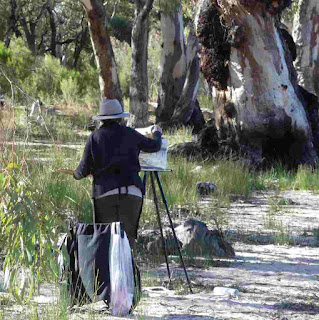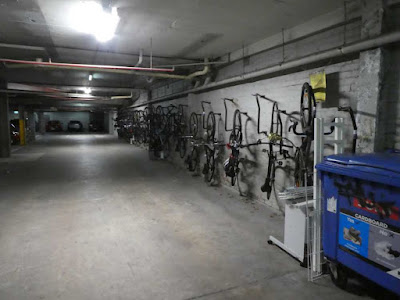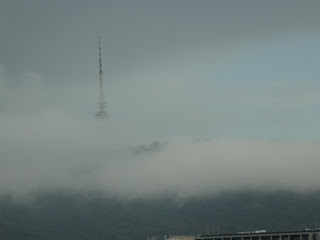Flatter than a tack
After the Adelaide Hills it was going to be flat. Notice the evenness of the horizon in this photo taken for somewhere just East of Mt Barker.
A bit further East, probably dropping down to Callington. The horizon is still a straight line.A bridge over the Murray at .... Murray Bridge.
We had never stopped in Peake before but a sign on the road had a magic word on it. The Council unfortunately failed to put up a second sign, and the khazi was tucked away behind the hall, rather than as we thought at the oval. Whatever, when located it provided the necessary services.
Not only is the country flat but the roads are pretty straight. I think this long stretch was from Pinnaroo to Ouyen.
Our aim was to visit Hattah-Kulkyne NP somewhat North of Ouyen. We headed for Lake Mournpull as that is where we had camped on several trips from Canberra to Adelaide in the past. Here is the route we followed.
En route we heard and saw a flock of White-browed Babblers: Bird of the Day. The Lake was pretty full: I recall at least one trip - possibly in the 1990s - when it was completely dry, with a huge pile of dead carp in the middle. Once the rain started buds on the roots of the huge red gums sprouted, forming a ring around the edge of the Lake.
There were warning signs - possibly permanent - about blue-green algae. I'm not sure about the blue element but there was certainly a lot of it.
This really is an artist, not someone looking at an information board as was the case at Hahndorf.Another artist had visited earlier and displayed pretty good draughtpersonship on the bark of one of the old red gums. Possibly not the usual meaning of a bark painting?
A few of the big old trees.
The commonest bird was Noisy Miners. Lots of them and very boisterous.
Before leaving we did the Nature Trail. A pleasant 1km stroll through some Mallee country. Very few birds in mid-afternoon, with Chestnut-rumped Thornbill being the most exciting.
On getting to our accommodation at the Robinvale Golf Course a non-countable (and indeed non-identifiable) owl was spotted. Presumably meant to keep the swallows from nesting here.
The venue was very new: possibly we were the first guests? No one else turned up. The bistro was shut on the Monday so we went to check what food was available in the town. Our pick was the Chinese restaurant. VERY authentic and pretty good: quick service and tasty food. We were surprised that Robinvale had a large Chinese community - unless they all turned out for tea that night!
- The latter number fascinated me, as there are a lot of 'things' around the town that relate to Aboriginal culture (see following post). So I looked at responses to another Census question which asked about Aborignal or Torres Straits Islander status: 227 indicated their status was Aboriginal. Did the 2nd response to the Ancestry question fill the gap? "Partially" would be the answer since a further 49 people gave Australian Aboriginal as their second response. The explanation is probably that many of the 227 people had a small proportion of their family tree coming from indigenous people - perhaps one grandparent or earlier ancestor.
- The second interesting point is that the "Australian" and "Australian Aboriginal" 1st responses leave 258 Oceanian people from other Oceanian ancestries. It turns out that 194 of them are Tongan. I am intrigued that there is such a large group in this fairly remote town with no obvious link to a group of South Pacific Islands.
I asked Swan Hill Rural City Council about the origins of the Tongan Community and have received the following interesting and helpful information."... the first family came to Robinvale in the late seventies to pick grapes. They were seasonal workers and followed the work. The family stayed on because there was work for most of the year. Friends and family then came to join them in Robinvale. In the eighties, large plantations of almonds were set up by Timbercorp which was a managed investment scheme and many of the trees were planted by these Tongan workers. "


















Comments
Post a Comment